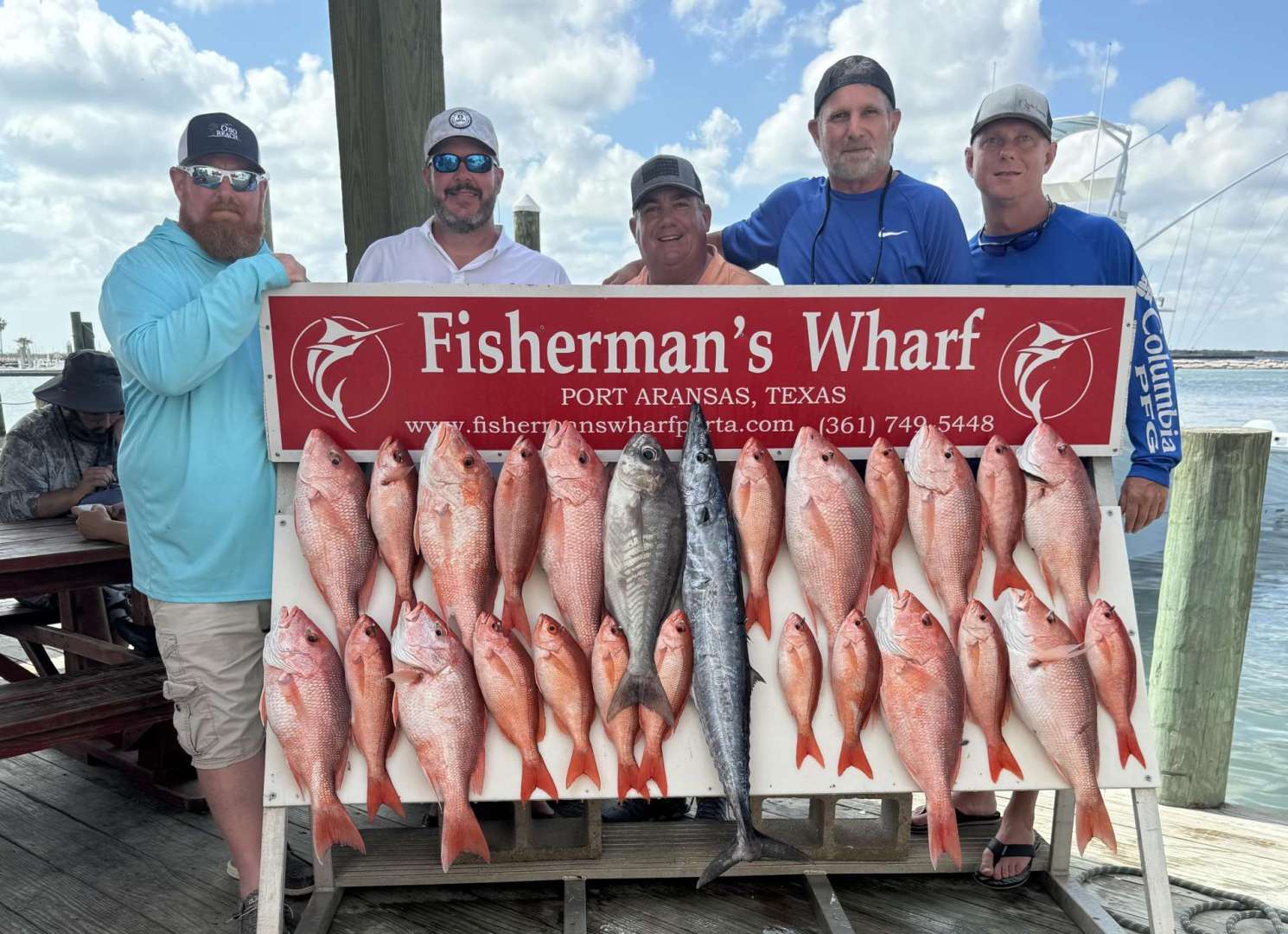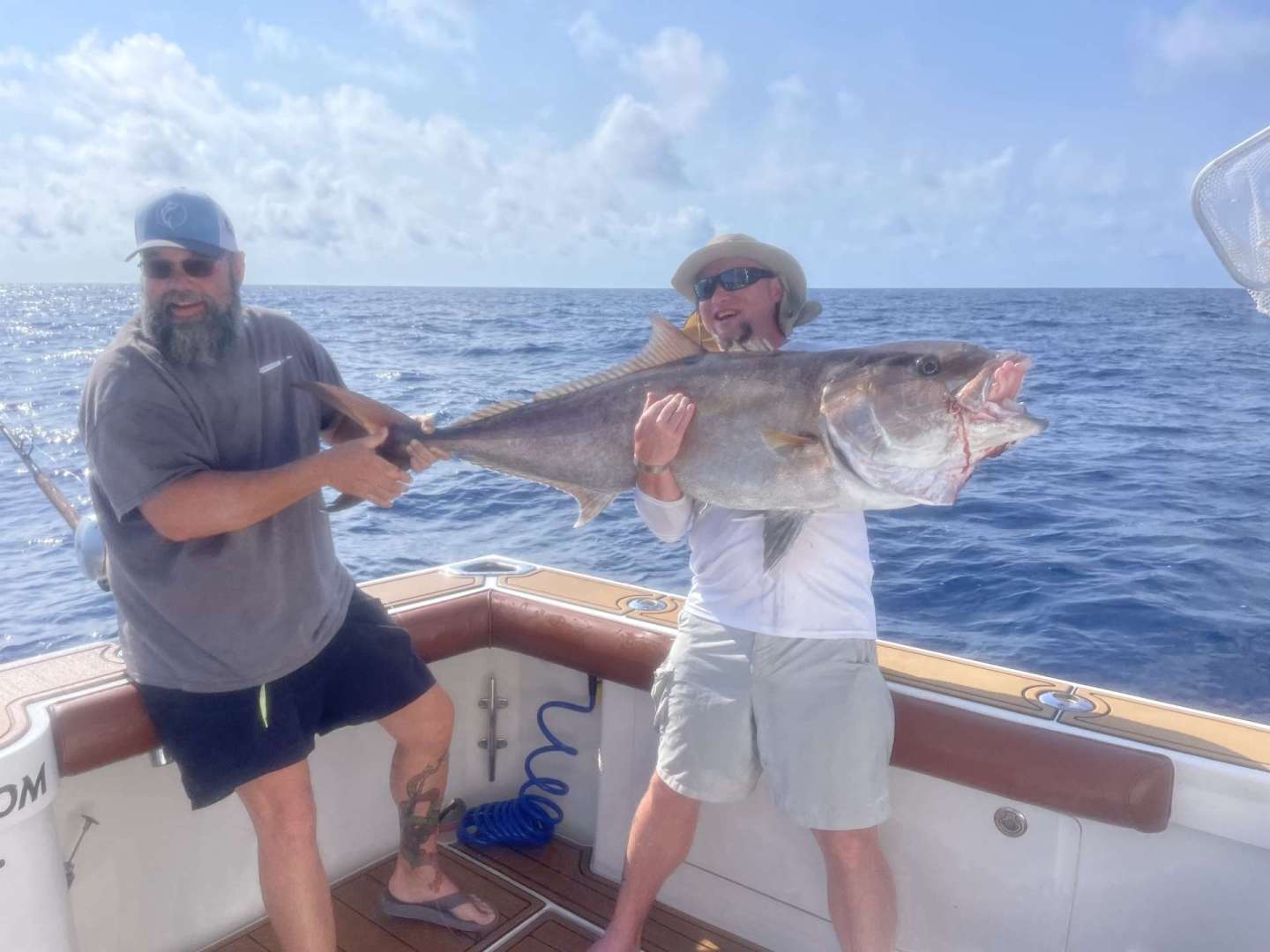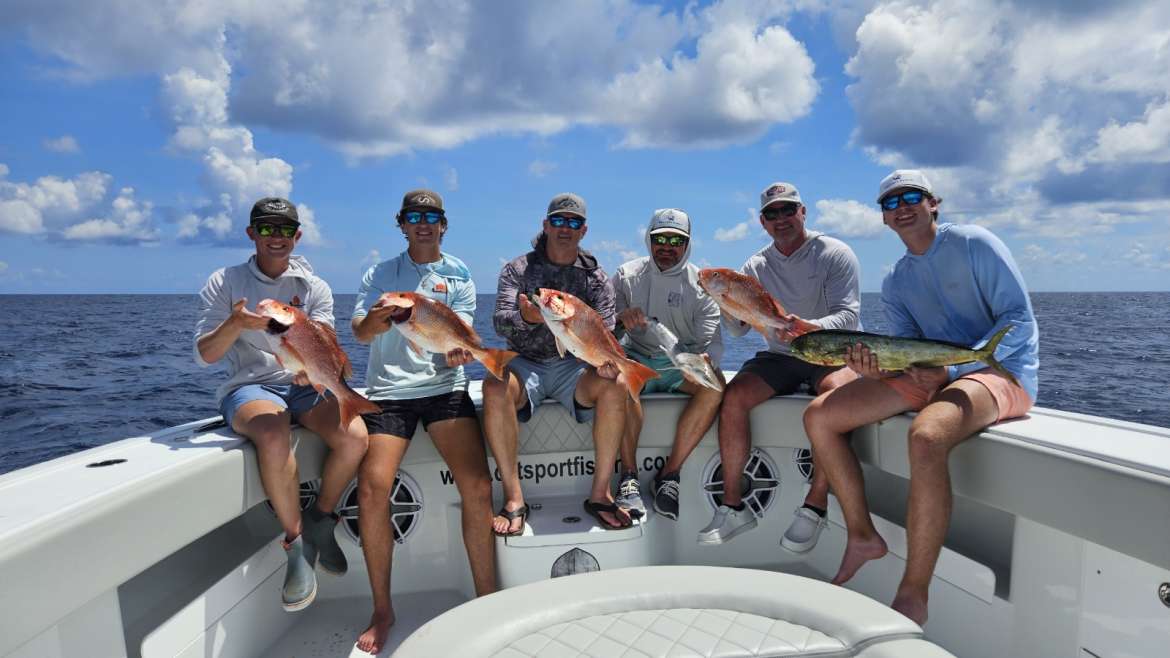Port Aransas has earned its reputation as one of the top fishing destinations on the Texas Gulf Coast, and for good reason. With year-round access to a wide range of inshore and offshore species, anglers from all over head to Port A in search of action-packed days on the water. But the bite doesn’t stay the same throughout the year. Seasonal shifts in weather, water temperature, and bait movement all play a role in what’s biting and when. That’s why understanding seasonal trends is key to planning a successful trip. In this Port Aransas fishing report, we’ll break down what anglers can expect during each season. You’ll learn which species are most active, what techniques tend to produce, and how local conditions shape the fishing experience. Whether you’re booking your first deep sea trip or are a seasoned Gulf Coast angler, this guide will help you time your trip and set the right expectations.
Why Seasonal Trends Matter for Port Aransas Fishing
Seasonal changes play a major role in fishing success along the Port Aransas coast. While fishing is possible year-round, different species become more or less active depending on water temperature, bait movement, and migratory behavior. Knowing when certain fish are most likely to bite can help anglers time their trips more effectively and improve their chances of landing quality catches.
Pelagic species like kingfish and mahi-mahi typically arrive in warmer months, while cooler seasons favor bottom fish like sheepshead and black drum. Local weather, currents, and wind patterns also shift with the seasons, influencing fish behavior and where guides choose to fish. Additionally, regulations such as snapper season openings vary throughout the year, making timing even more important. Experienced guides use seasonal trends to adjust tactics and locations. Understanding these patterns helps anglers align their expectations and target the right species for the time of year.
Spring Fishing Trends (March – May)
Water Conditions and Bait Patterns
As spring arrives in Port Aransas, water temperatures gradually climb into the mid-60s and low 70s, setting the stage for a shift in bait movement and fish activity. Warmer currents from the Gulf push in closer to shore, bringing with them schools of menhaden, mullet, and sardines. These baitfish become a reliable food source for larger predators and signal the beginning of more active feeding patterns. Water clarity can vary depending on wind and rainfall, but spring generally offers improving visibility compared to winter. This change allows for more productive offshore and nearshore fishing, especially when paired with calm weather windows in April and May.
Species to Target
Spring is a transitional season that opens the door to a wider variety of species. Kingfish are among the earliest offshore predators to arrive, typically showing up in April. Jack crevalle also move into the area in large schools, offering hard fights for anglers looking for a challenge. On longer trips, early mahi-mahi may start to appear toward the end of May when water temperatures rise and floating weed lines form offshore. Inshore anglers can also expect steady action from redfish and speckled trout, especially during warming trends.
Tactics and Techniques
Spring fishing requires a flexible approach due to changing weather and variable water conditions. For kingfish and jacks, slow trolling with ribbonfish or diving plugs near structure and bait schools is often effective. On calmer days offshore, sight fishing around weed lines or shrimp boats can produce surprise catches. For inshore species, drifting over grass flats or working soft plastics along drop-offs continues to be productive. Guides often monitor temperature swings and adjust their approach based on current conditions, helping clients stay on fish throughout the season. Spring is a time of opportunity, and with the right techniques, it can deliver action-packed days on the water.

Summer Fishing Trends (June – August)
Offshore Opportunities
Summer is the peak season for offshore fishing in Port Aransas. Warm Gulf waters stabilize in the upper 70s to mid-80s, creating prime conditions for a wide range of pelagic species. Long-distance runs offshore often lead to encounters with yellowfin tuna, mahi-mahi, wahoo, and occasional sailfish. Weed lines, temperature breaks, and oil rigs become hotspots for these migratory fish. Charter trips this time of year may include trolling, chunking, or drifting depending on target species and sea conditions. Kingfish remain abundant closer to shore, and their aggressive strikes make them a popular choice for half-day trips. The Federal red snapper season typically opens in early summer, making it a major draw for anglers targeting reef structure and bottom species during this window.
Inshore Heat
While offshore waters are full of opportunity, inshore and nearshore fishing also heats up during summer. Tarpon begin to migrate along the beaches and channels, giving dedicated anglers a chance at one of the most exciting game fish on the Texas coast. These fish are often spotted rolling or feeding near the surface and are best targeted with live bait or large artificial lures. For those looking to stay closer to shore, jetties and surf zones can produce speckled trout, redfish, and Spanish mackerel during early morning or evening hours when temperatures are lower and fish are more active.
Weather Considerations
Summer offers some of the calmest seas and longest fishing windows of the year, but it also comes with challenges. High temperatures and humidity can take a toll on anglers and gear, so early departures and plenty of hydration are important. Afternoon storms can build quickly, especially in July and August, so monitoring the forecast and staying in contact with the marina is essential. Guides often schedule trips early in the morning to avoid the heat and to take advantage of cooler surface water temperatures, which tend to encourage more feeding activity. Knowing how to adjust start times and trip duration helps keep guests safe and improves overall success. Summer may be busy, but the fishing action and variety make it one of the most rewarding seasons to be on the water in Port Aransas.
Fall Fishing Trends (September – November)
Changing Currents and Cooler Temps
As fall arrives in Port Aransas, water temperatures begin to drop gradually from the mid-80s to the upper 60s by late November. These cooler conditions trigger major transitions in fish behavior. Baitfish begin to migrate out of the bays and estuaries into deeper waters, followed closely by predator species. Currents shift as seasonal winds pick up, especially during the first strong cold fronts in October. These environmental changes increase feeding activity, as fish prepare for the winter months. The result is often a more aggressive bite both inshore and offshore, with clearer water and lower boat traffic compared to summer.
Best Fall Species
Fall offers some of the most consistent action of the year, especially for anglers targeting redfish. Large bull reds gather near jetties, surf zones, and passes during their annual spawning run in September and October. These fish can be caught with live mullet, crab, or cut bait on heavier tackle. Kingfish remain active offshore and nearshore through early fall before tapering off as temperatures drop. Inshore, flounder become a primary target as they begin their migration toward the Gulf, making them more predictable along channels and flats. Black drum and speckled trout also feed more frequently during this time, offering reliable action for anglers using live shrimp or soft plastics.
Techniques That Work
Successful fall fishing often comes down to timing and bait selection. Anglers targeting bull reds typically do best near the jetties or surf during tidal swings, especially when water is moving strongly. Flounder can be caught with slow presentations near structure, such as jigging soft plastics along drop-offs or using live mud minnows. Offshore fishing, trolling for kingfish remains productive into October using spoons or ribbonfish, while bottom fishing around reefs can produce steady bites from snapper, triggerfish, and amberjack when seasons allow. Guides pay close attention to cold fronts and moon phases to time outings and adjust locations. With fewer crowds and more cooperative fish, fall is a smart choice for anglers looking for a high-yield fishing experience.
Winter Fishing Insights (December – February)
Slower Days, Big Rewards
Winter brings cooler weather and fewer crowds to Port Aransas, creating a quieter but still productive fishing season. Water temperatures dip into the low 60s and even high 50s by January, slowing down the metabolism of many species. While the pace may be more relaxed, patient anglers can still find success, especially when targeting cold-tolerant fish inshore and around structure. The reduced boat traffic also means less fishing pressure, giving locals and winter visitors better access to popular spots. With the right timing and technique, winter can offer consistent opportunities for anglers willing to adjust to the season’s slower rhythm.
Deep Drops and Bottom Fishing
This is a strong time of year for targeting bottom-dwelling species offshore. Deep dropping around reefs and wrecks can produce amberjack, vermilion snapper, and triggerfish, depending on what seasons are open. Grouper are also an option, especially on longer trips where guides can access deeper waters with less competition. Heavy tackle, large cut baits, and electric reels are often used for these deeper targets. Nearshore trips may shift focus to structure fishing for sheepshead, which gather around jetties, bridges, and pilings. Their bite is subtle but reliable during colder months, especially when using fiddler crabs or shrimp.
Inshore Consistency
Winter is one of the most dependable seasons for targeting black drum, redfish, and speckled trout in the bays and channels. These species tend to group tightly and move slowly in cooler water, making them easier to locate once a pattern is found. Black drum, in particular, provide steady action near deep holes and drop-offs, often caught on dead shrimp or crab. Redfish remain active along mudflats and grass lines where the sun warms the water. Speckled trout often hold in deeper bay channels and respond well to soft plastics worked slowly across the bottom. Guides often rely on precise positioning and finesse presentations to stay productive in winter conditions. While it may not have the variety of other seasons, inshore fishing in Port Aransas is dependable and rewarding for those who are prepared.

Preparing for Your Trip: What Anglers Should Know
Booking the Right Time
Choosing the right season for your fishing trip can make a big difference in results. Different species peak at different times, so aligning your trip with what’s biting helps set expectations and improves your chances of success. Red snapper season is limited to early summer, while tarpon and kingfish are more common from late spring through early fall. Winter trips are ideal for steady inshore action with black drum and sheepshead. Booking early helps secure prime dates, especially during busy months.
Gear and Licensing
Most Port Aransas charters, including CAT Sport Fishing, supply all rods, reels, bait, and tackle. You should still bring essentials like sunscreen, sunglasses, proper footwear, and clothing for the weather. A light jacket works well in cooler months, while breathable clothes help in the heat. Anyone 17 or older will need a Texas saltwater fishing license, which is easy to purchase online or locally. Being on time, listening to safety instructions, and staying flexible with plans ensures a smooth and enjoyable day on the water.
Frequently Asked Questions
What is the best month to fish in Port Aransas?
June is often considered the best month for fishing in Port Aransas due to the start of red snapper season and the arrival of pelagic species like mahi-mahi and kingfish. Warm water and calm conditions offer more fishing opportunities both offshore and inshore. However, great fishing can be found throughout the year depending on your target species.
What fish are biting in Port Aransas right now?
The fish biting in Port Aransas vary by season, but common catches include redfish, trout, snapper, kingfish, and black drum. Offshore trips often produce mahi-mahi and tuna in summer, while winter favors sheepshead and redfish inshore. Checking a seasonal report or talking to a local guide will provide the most accurate information for your timing.
Do you need a fishing license to fish in Port Aransas?
Yes, anglers aged 17 and older need a valid Texas saltwater fishing license to fish in Port Aransas. Licenses can be purchased online or at most tackle shops and sporting goods stores. Charter trips may include license details in their booking instructions, so it’s best to confirm before your trip.
Can you keep the fish you catch on a Port Aransas charter?
In most cases, you can keep your catch as long as it meets Texas Parks and Wildlife regulations for size and season. Guides will help you identify what’s legal to retain and often clean and bag your fish for you. Certain species, like red snapper, may only be kept during open federal seasons.
What kind of fish can you catch offshore in Port Aransas?
Offshore trips from Port Aransas target a wide range of species including red snapper, kingfish, mahi-mahi, tuna, sailfish, and amberjack. Seasonal patterns and distance from shore influence what species are most active. Longer trips tend to access deeper water and increase the chance of catching pelagic fish.
Is deep sea fishing better in the summer or winter in Port Aransas?
Summer offers the best conditions for deep sea fishing due to warmer water, calmer seas, and the presence of migratory species like mahi-mahi and tuna. Winter deep sea trips are still possible but tend to focus more on bottom fishing for species like snapper and grouper. Trip availability and target species should guide your seasonal choice.
Plan Your Next Port Aransas Fishing Trip with Confidence
Fishing in Port Aransas offers something for everyone, but timing your trip around seasonal trends can make all the difference. Each season brings its own opportunities, whether it’s chasing pelagics in the summer, bull reds in the fall, or steady inshore action during the winter months. Understanding how weather, water temperatures, and regulations impact fishing success helps anglers set realistic goals and enjoy a more productive trip. From offshore action to quiet bay days, planning with the right knowledge and preparation is key.
At CAT Sport Fishing, our experienced team is here to help you make the most of every season. Whether you’re looking for a full-day offshore adventure or a family-friendly nearshore trip, we’ve got the gear, the know-how, and the local insight to get you on the fish. Book your next Port Aransas fishing trip with CAT Sport Fishing today and let our crew show you what the Gulf has to offer.


